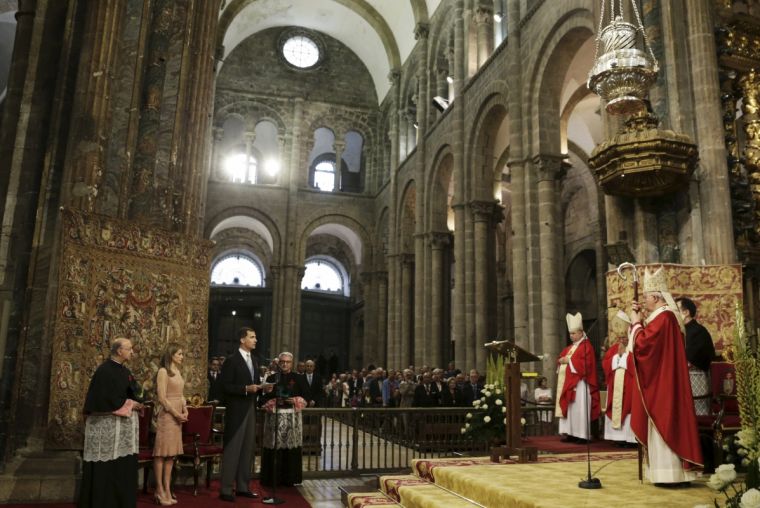This old spiritual practice is making a unexpected comeback. Why?

There is nothing new under the sun, so maybe it shouldn't be surprising that many old or even ancient spiritual practices are finding their way back into evangelical, Pentecostal and other Protestant Churches where they would have been almost completely alien only a couple of generations ago.
From the use of the Jesus Prayer to an increased interest in liturgical worship, a rediscovery of traditions long since cast aside is one of the most interesting features of 21st-century evangelicalism.
With this in mind, I travelled to Santiago de Compostela last week. The city, in northern Spain, was teeming with visitors from across the continent and around the world. They were drawn by the Feast of St James, the disciple whose body is alleged to be buried in the extravagant cathedral at the heart of the old city of Santiago. We prayed and worshipped in this place where generations have done so before us. We even had the privilege of watching the giant 'botofumeiro' thurible used – quite an experience.
Best. Thurible. Ever...#FestasdoApóstolo #SantiagoDeCompostela pic.twitter.com/I9Hxx2UhVm
— Andy Walton (@waltonandy) July 25, 2017
From solo pilgrims to large groups, the streets were filled with people who'd reached the climax of a pilgrimage along the Camino – the ancient route which came to peak popularity in medieval Europe as Christians from across the continent came to Santiago.
A recent report in the Church Times pointed out that, 'Pilgrims on the Way of St James... have risen from 5,000 in 1991 to more than 277,000 last year, and are forecast to almost double again to 464,000 by 2021.' The interest is mirrored elsewhere with other pilgrimage routes increasing in popularity, old routes being revived and new ones planned. Books are being written about pilgrimage, while a recent BBC TV series traced pilgrimage routes from the holy island Lindisfarne in the north east of England, through France and Spain, all the way to Jerusalem.
In a new book which encompasses pilgrimages old and new, The Pilgrim Journey, James Harper examines the history of these treks which can last for hundreds of miles. Pilgrimage, 'evolved tentatively in the early centuries of Christianity', he writes, 'flourished in the Middle Ages, diminished after the Reformation, became diluted in the Age of Enlightenment, and revived in the nineteenth and twentieth centuries. But even at its lowest ebb, it has never disappeared.'
What is it, then, which is persuading increasing number of Christians, and some non-believers, to go on pilgrimages near and far?
I can see three main factors at play.
First, Western evangelicals and other Protestants have begun to discover the riches of the tradition of the wider Church. For generations after the Reformation, Protestant churches mostly steered well clear of anything which reminded them of their Catholic heritage. But in recent decades, the ecumenical movement and the internet have given us access to learn for ourselves about the transformational stories that many have told from their experiences of pilgrimage.
Second, it's much easier, practically, to go on a pilgrimage today. Transport, accommodation and route planning are all very simple in the 21st century. Going on a pilgrimage is as straightforward taking a beach holiday but potentially much more rewarding than a couple of weeks on a sun lounger.
Finally, in our technologically advanced world, there seems to be a desire to reach out for something which has stood the test of time. Pilgrimage has been offering a spiritual renewal for hundreds of years. If the latest app to help you organise your diary isn't quite hitting the spot, and half an hour of mindfulness before work isn't doing the job, then why not try pilgrimage?
The number of young people in Santiago was an indication that the trend is set to continue to rise. Pilgrimage is set to become an increasing part of the spiritual landscape in the 21st century. Places which have been prayed in for thousands of years, routes which have been trodden by thousands of pairs of feet and buildings which have stood longer than governments of all stripes – these symbols of permanence matter in an ever changing world.
Celtic Christians talked about 'thin places' – locations where the boundary between heaven and earth seemed especially porous. Some of their own treasured sites such as Iona, Lindisfarne and even humble Bradwell-on-Sea in Essex have increasingly become sites of pilgrimage in recent years. I, for one, will be putting on my walking boots and seeking out their ancient footsteps, and the wisdom that goes along with them.
Follow Andy Walton on Twitter @waltonandy











